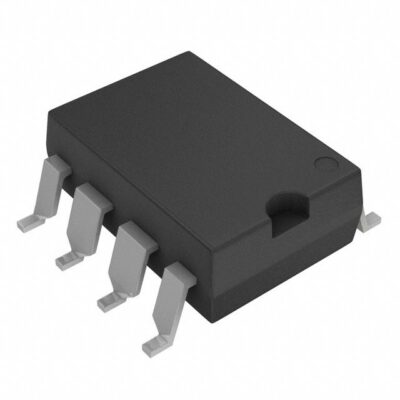ISO1050DUBR
Part Number: ISO1050DUBR
Manufacturer: Texas Instruments
Description: IC TXRX/ISO HALF 1/1 8SOP
Shipped from: Shenzhen/HK Warehouse
Stock Available: Check with us
ICRFQ.com - Electronic Components Distributor in China Since 2003

Part Number: ISO1050DUBR
Manufacturer: Texas Instruments
Description: IC TXRX/ISO HALF 1/1 8SOP
Shipped from: Shenzhen/HK Warehouse
Stock Available: Check with us
| Datasheet | |
|---|---|
| Category | Integrated Circuits (ICs) |
| Family | Interface – Drivers, Receivers, Transceivers |
| Manufacturer | Texas Instruments |
| Series | – |
| Packaging | Tape & Reel (TR) |
| Part Status | Active |
| Type | Transceiver |
| Protocol | CAN |
| Number of Drivers/Receivers | 1/1 |
| Duplex | Half |
| Receiver Hysteresis | 150mV |
| Data Rate | 1Mbps |
| Voltage – Supply | 3 V ~ 5.5 V |
| Operating Temperature | -55°C ~ 105°C |
| Mounting Type | Surface Mount |
| Package / Case | 8-SMD, Gull Wing |
| Supplier Device Package | 8-SOP |
The ISO1050DUBR is vital in Controller Area Network (CAN)-based industrial automation, control system, and other application domains. This high-tech, galvanically separated CAN transceiver is built to ISO11898-2’s exacting specifications, so it can transmit data securely and reliably in any environment. The important components of the ISO1050DUBR, including as its features, applications, and the benefits it delivers to many industries, will be covered in this in-depth overview.
The ISO1050DUBR provides galvanic isolation and is a high-performance CAN transceiver. To get up to 2500 VRMS of isolation in the ISO1050DUBR model, a silicon oxide (SiO2) insulation layer is used to physically separate the logic input and output buffers. The ISO1050DW variant boasts an even more remarkable 5000 VRMS isolation capability. This is a crucial safety measure because noise currents from the data bus or other circuits can disrupt or even destroy sensitive hardware if they find their way into the local ground.
The ISO1050DUBR is a differential transmitter and receiver for the CAN bus and CAN controller, respectively, and it can handle signaling rates of up to 1 Mbps. For this reason, it’s well-suited for use in fast data transmission across a wide range of programs.
The ISO1050DUBR and ISO1050DW are both ISO11898-2 compliant. This assures that they meet the demanding CAN communication protocol standards, providing reliability and compatibility in CAN networks.
ISO1050DUBR provides dependable 2500 VRMS isolation while maintaining a high level of galvanic isolation, making it suited for a wide range of applications.
Both versions include fail-safe outputs, which ensure that the outputs are guided to a safe state in the case of a failure or power outage. This is an important safety feature that prevents unexpected or harmful operation.
The ISO1050DUBR and ISO1050DW both have minimal loop delays, with a typical delay of 150 ns. This low latency enables high-speed data transmission, which is critical for real-time applications.
With a typical transient immunity of 50 kV/s, these transceivers provide high immunity to transient voltage spikes, protecting CAN bus communication from electrical disruptions.
With a wide operating range of -27 V to 40 V, these devices provide bus-fault protection, preserving data transmission integrity even in difficult electrical situations.
The presence of a driver dominant time-out function contributes to the network’s stability and reliability by avoiding indefinite domination of a single node on the CAN bus.
Both transceivers’ I/O voltage ranges support 3.3 V and 5 V microprocessors, making them highly adaptable and compatible with a wide range of systems and components.
Because of its strong architecture and versatile functionality, the ISO1050DUBR is used in a wide range of sectors. Here are a few examples of areas where it excels:
The ISO1050DUBR is critical in industrial automation for enabling reliable communication between various components and systems, ensuring smooth and efficient operations.
It aids in the efficient regulation of temperature and environmental conditions in building management and HVAC systems.
For security applications, the transceiver allows secure communication between security equipment, hence improving premises security.
The ISO1050DUBR is used for data transfer and control in transportation systems such as automotive and aviation.
It supports communication in many medical equipment, contributing to the effectiveness of healthcare systems.
Telecommunication systems rely on the ISO1050DUBR for efficient data transmission, which improves service quality.
The ISO1050DUBR, a galvanically isolated CAN transceiver, is designed with a number of key features to provide smooth and reliable communication within Controller Area Network (CAN) systems. This device’s CAN bus states and digital inputs/outputs are critical components. Let’s take a closer look at what these features entail:
TXD (Input) and RXD (Output):
Dominant Time-Out (DTO) TXD
In summary, the ISO1050DUBR’s CAN bus states, digital inputs, and protective features are critical in guaranteeing the dependable and resilient functioning of CAN communication networks. Understanding these factors is critical for efficient data transmission and fault tolerance in a variety of industrial and automotive applications.
The ISO1050DUBR and ISO1050DW are versatile and dependable CAN transceivers that are designed to meet the ISO11898-2 standard. These devices are well-equipped to assure the integrity and safety of data transfer in a variety of applications, thanks to their remarkable isolation capabilities, fail-safe outputs, minimal loop delays, transient immunity, bus-fault protection, and diverse I/O voltage ranges. Their compliance with a slew of safety certificates demonstrates their applicability for businesses where safety and dependability are critical.
Improve the performance of your projects by including this amazing component. Contact ICRFQ, your dependable Chinese electrical component supplier, as soon as possible. Make the most of the ISO1050DUBR’s potential by putting your ideas into action.
WhatsApp us